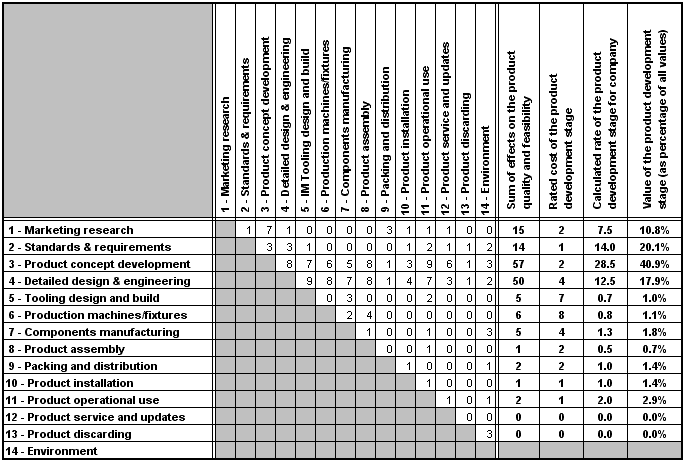Many
organizations do not analyze designs with the final product
costs reduction criteria and do not study
effects
of the product creation on the final cost of the product
and on its quality.
There
are several ways to estimate value of all stages of the
particular product creation from the first idea
up
to
the
production launch. Evaluation with the correlation matrix
is quite simple to use and can illustrate
impact
of
the
subsequent steps of the product creation on the cost and
quality of the final product.
That
evaluation can be completed by intuitive ranking of the
cause-effect impact of each step of the product
creation
on the next stages of that product creation and on the product
functional live until its disposal.
First,
all significant stages and processes of the particular product
creation and its functional life should be
listed
for evaluation. Most of products would have the following
phases;
1 -
Marketing research
2 - Products needs & requirements description
3 - Product concept development
4 - Detailed design & engineering
5 - Tooling design and build
6 - Production machines and fixtures
7 - Components manufacturing
8 - Product assembly (attaching parts together)
9 - Packing, distribution and sale
10 - Product installation
11 - Product operational use and attractiveness
12 - Product service and updates
13 - Product discarding (recycling/reuse/disposal)
14 -
Environment impact (from marketing to product disposal)
15 -
Product price and company profit
Each
dependence and impact on subsequent stages can be estimated
with question:
- How
strong is the influence of the particular stage and process
of the product development on feasibility
and
quality
of
the next subsequent stages or processes,
- or,
how tight is the particular stage or process linked with
the subsequent stages or processes.
Ranking
of each relation can be described by using any preferred
quantitative scale with
the lowest mark
for
no-relation up to the highest for the maximum dependence,
and scale must be constant for the entire
table;
i.e. scale from 0 to 10 or from 0% to 100%. Summary of all
individual rankings for each particular
stage
or process represents its entire "Effect on the product
feasibility and quality" that is related to the
importance
of the particular stage or process for all subsequent
stages or
processes of the product
development
or life.
The
next step is to describe cost of each stage of the product
development and costs for maintaining the
products
functions.
Those
costs can be estimated with actual monetary values or just
illustrated with the
comparative
ranking scale.
Effect
of the particular development stage divided by the related
cost results in ratio that represents the
values
of
the particular stage of the product development, where value
has standard meaning of qualities
vs.
cost of
achieving those qualities.
For
example, the plastic mechanical toy to be assembled at home
from prepared modules by customer
would
have
values estimation similar to the presented matrix:

The
above comparison of values shows where are the most effective
areas for the product cost controls
and
for quality
with market attractiveness improvements. It can be expected
that investing into the most
valuable
stages of
the product development should result in proportional improvement
of the product
quality
from that stage. This
ranking illustrates only the subsequent values of the product
development
and
maintaining its later life. This
model does not illustrate quality effects from the management.
Design
Cost
Product
design cost is related to the entire work required for the
product design development, and size of
the
required
design team depends on timing constraints.
Product
design cost can be described on several different ways.
Some organizations just guess and may
exaggerate,
some
allocate to design a fix percentage of the awarded business
value and others estimate
cost
of design and form
the design team based on comparison to previous design projects.
Very few
companies
have detailed guidelines
for the design projects timing and cost calculation. That
information
can
come mostly recording of timing details during multiple
product designs.
If the
design team is experienced and its skills with effectiveness
are known then it is possible to predict
the
design
time and cost with about 10% tolerance range. That requires
to have a track of the design time
for
different
previous products and their components at all stages of
the design process including: concept,
general
design, components and details development, engineering
analysis, reviews, drawings, etc.
The
design timing and cost guideline allows for quite precise
design plan with all needed activities.
Detail
design
plan is very valuable for the design management since it
allocates necessary time and
enables very
effective
design control for achieving high quality of the product
design
|

